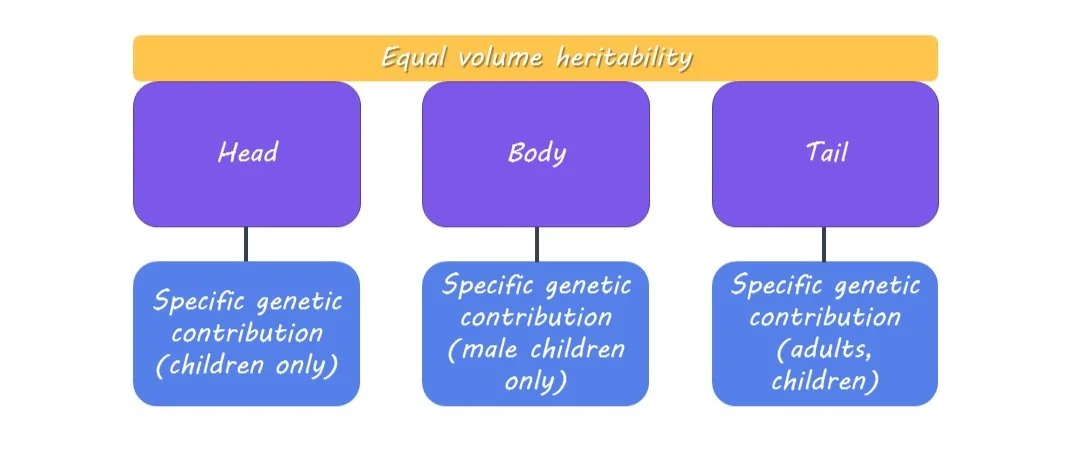Brain Volume in the Hippocampus is Influenced by Genetics
Post by Lani Cupo
The takeaway
Gray matter volume along the length of the hippocampus is influenced by genetic factors, which can be identified in living humans.
What's the science?
The volume of the hippocampus is considered to be about 80% “heritable”, meaning 80% of the variability of hippocampal volume is attributable to genetic variation. Measuring the volume of the entire hippocampus, however, neglects to consider that some regions of the hippocampus may be more susceptible to environmental influences than others. Examining the heritability of subfields, or regions within the hippocampus, may provide better estimates of whether the heritability of volume differs between regions. This week in NeuroImage, Pine and colleagues investigated the heritability of hippocampal subfields using magnetic resonance imaging (MRI) data, finding volume is influenced both by genetic factors general to the entire hippocampus, and specific to individual subfields.
How did they do it?
The authors used MRI from both children and adult twin pairs from three different datasets, including both dizygotic and monozygotic twins. They built biometric models to compare how highly correlated volumes were between monozygotic (single egg) and dizygotic (two eggs) twins. This method allowed them to detect differences in hippocampal subfield volume that could be attributed to sources of variance that are either genetic or environmental. For example, if there is variance in the hippocampal volumes of monozygotic twins (who begin life genetically identical) it can be attributed to an individual environmental influence (e.g. different levels of education). By examining how correlated hippocampal volumes were between monozygotic twins, compared to how shared hippocampal volumes were between dizygotic twins, the authors could estimate how much of the volume was heritable versus due to environmental influences. They compared the performance of different models to assess which one best fit their data before interpreting results. The hippocampal subfields examined were the head, body, and tail, dividing the hippocampus along its longitudinal axis (if you imagine the hippocampus as a c-shape uncurled). By including both males and females and both children and adults in this study, the authors were able to investigate how heritability by subfield differs across sexes and ages.
What did they find?
The authors didn’t find any differences in the heritability of volume across the different subfields. This suggests there isn’t a particular subfield where volume is more heritable than others, however, it is possible that using another division of the hippocampus or treating it as a gradient, rather than distinct regions, may reveal other subtle differences.
Nevertheless, the authors did find evidence for subregion-specific genetic components, meaning different genes might contribute to the volume of different subfields. Subfield-specific genetic contribution was found to be both sex and age-dependent. In both sexes and in both children and adults, subfield-specific genetic contributions were found for the tail of the hippocampus. In contrast, subfield-specific genetic contributions were found for the head only in children (both sexes). Finally, subfield-specific contributions were found for male children only for the body of the hippocampus. The authors reported that these sex and age differences do not follow known systematic patterns, however, it is of interest that the genetic influence on hippocampal subfield volume is not constant across ages, and other properties of the hippocampus, such as white matter, may better reflect age-related changes.
What's the impact?
These findings suggest the head, body, and tail may not show differences in heritability of gray matter volume, however, they show subfield-specific genetic contributions that differ across subfields by age and sex. The authors also demonstrate that noninvasive imaging can be used in living humans to estimate genetically based individual differences, which can set the stage for future population studies.


